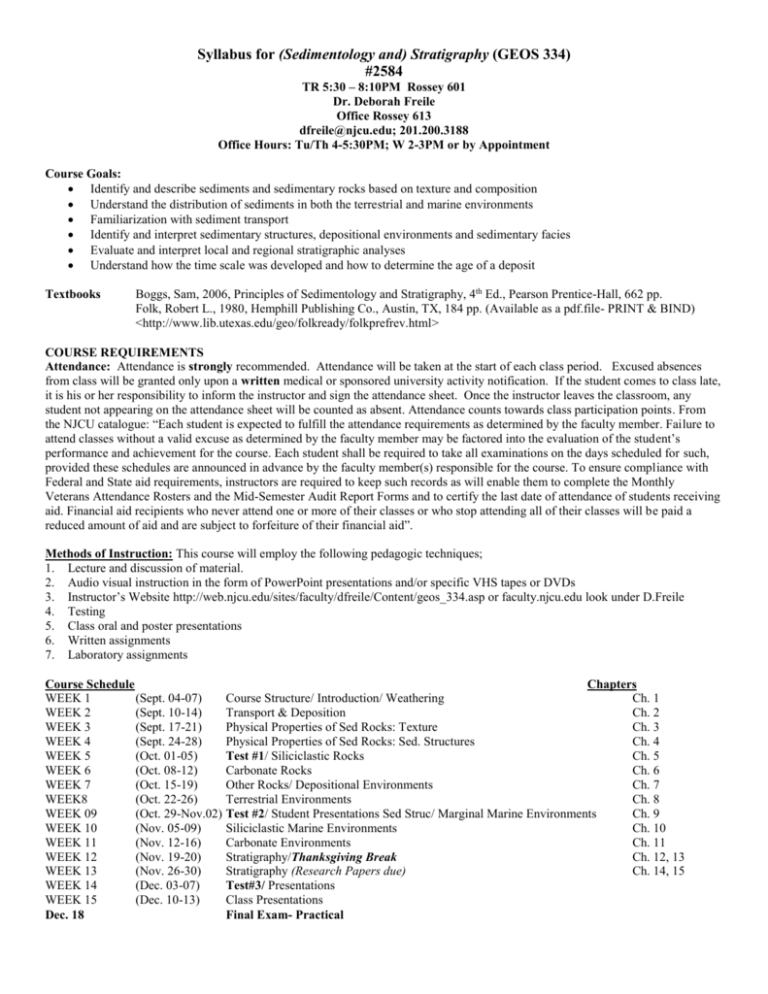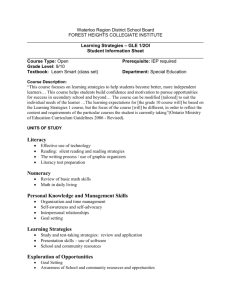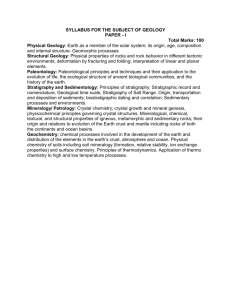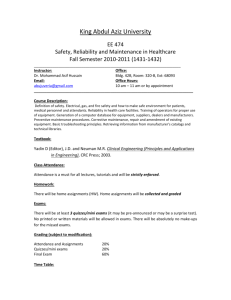
Syllabus for (Sedimentology and) Stratigraphy (GEOS 334)
#2584
TR 5:30 – 8:10PM Rossey 601
Dr. Deborah Freile
Office Rossey 613
dfreile@njcu.edu; 201.200.3188
Office Hours: Tu/Th 4-5:30PM; W 2-3PM or by Appointment
Course Goals:
Identify and describe sediments and sedimentary rocks based on texture and composition
Understand the distribution of sediments in both the terrestrial and marine environments
Familiarization with sediment transport
Identify and interpret sedimentary structures, depositional environments and sedimentary facies
Evaluate and interpret local and regional stratigraphic analyses
Understand how the time scale was developed and how to determine the age of a deposit
Textbooks
Boggs, Sam, 2006, Principles of Sedimentology and Stratigraphy, 4th Ed., Pearson Prentice-Hall, 662 pp.
Folk, Robert L., 1980, Hemphill Publishing Co., Austin, TX, 184 pp. (Available as a pdf.file- PRINT & BIND)
<http://www.lib.utexas.edu/geo/folkready/folkprefrev.html>
COURSE REQUIREMENTS
Attendance: Attendance is strongly recommended. Attendance will be taken at the start of each class period. Excused absences
from class will be granted only upon a written medical or sponsored university activity notification. If the student comes to class late,
it is his or her responsibility to inform the instructor and sign the attendance sheet. Once the instructor leaves the classroom, any
student not appearing on the attendance sheet will be counted as absent. Attendance counts towards class participation points. From
the NJCU catalogue: “Each student is expected to fulfill the attendance requirements as determined by the faculty member. Failure to
attend classes without a valid excuse as determined by the faculty member may be factored into the evaluation of the student’s
performance and achievement for the course. Each student shall be required to take all examinations on the days scheduled for such,
provided these schedules are announced in advance by the faculty member(s) responsible for the course. To ensure compliance with
Federal and State aid requirements, instructors are required to keep such records as will enable them to complete the Monthly
Veterans Attendance Rosters and the Mid-Semester Audit Report Forms and to certify the last date of attendance of students receiving
aid. Financial aid recipients who never attend one or more of their classes or who stop attending all of their classes will be paid a
reduced amount of aid and are subject to forfeiture of their financial aid”.
Methods of Instruction: This course will employ the following pedagogic techniques;
1. Lecture and discussion of material.
2. Audio visual instruction in the form of PowerPoint presentations and/or specific VHS tapes or DVDs
3. Instructor’s Website http://web.njcu.edu/sites/faculty/dfreile/Content/geos_334.asp or faculty.njcu.edu look under D.Freile
4. Testing
5. Class oral and poster presentations
6. Written assignments
7. Laboratory assignments
Course Schedule
Chapters
WEEK 1
(Sept. 04-07)
Course Structure/ Introduction/ Weathering
Ch. 1
WEEK 2
(Sept. 10-14)
Transport & Deposition
Ch. 2
WEEK 3
(Sept. 17-21)
Physical Properties of Sed Rocks: Texture
Ch. 3
WEEK 4
(Sept. 24-28)
Physical Properties of Sed Rocks: Sed. Structures
Ch. 4
WEEK 5
(Oct. 01-05)
Test #1/ Siliciclastic Rocks
Ch. 5
WEEK 6
(Oct. 08-12)
Carbonate Rocks
Ch. 6
WEEK 7
(Oct. 15-19)
Other Rocks/ Depositional Environments
Ch. 7
WEEK8
(Oct. 22-26)
Terrestrial Environments
Ch. 8
WEEK 09
(Oct. 29-Nov.02) Test #2/ Student Presentations Sed Struc/ Marginal Marine Environments
Ch. 9
WEEK 10
(Nov. 05-09)
Siliciclastic Marine Environments
Ch. 10
WEEK 11
(Nov. 12-16)
Carbonate Environments
Ch. 11
WEEK 12
(Nov. 19-20)
Stratigraphy/Thanksgiving Break
Ch. 12, 13
WEEK 13
(Nov. 26-30)
Stratigraphy (Research Papers due)
Ch. 14, 15
WEEK 14
(Dec. 03-07)
Test#3/ Presentations
WEEK 15
(Dec. 10-13)
Class Presentations
Dec. 18
Final Exam- Practical
WEB and Email. I will endeavor to post the syllabus, notes and exercises on the Web ASAP. Any notices that appear on the
Website are your responsibility. Check it often. You are held responsible for all information emailed on your student accounts.
LABORATORY. Laboratory is essential for applying what we discuss in class. Laboratories will be interspersed with the lectures.
There will be 5 or 6 Labs. Laboratory generally begins with a short lecture. The exercises will usually be posted on the Web in
advance so familiarize yourself with the material. Working in teams is encouraged but you will be tested individually on this material
on both the lab practical and examinations so make sure you know it yourself. Finish the work in the time allotted. The samples will
be available in the room at other times for you to finish the lab. Laboratory exercises are due at the start of the next period unless
stated otherwise. You will lose a grade for each day it is late. There are no make-ups for lab. If you know in advance you will miss a
laboratory, you must speak with me. There is NO makeup for the practical exam. Many labs require a calculator, ruler as well as
regular and colored pencils. A hand lens is essential. Come prepared.
FIELD TRIPS. We will have two field trips: a weekend trip to western NJ and Pennsylvania (October 12-13-Date Firm) and a
weekend trip to the Connecticut River Valley area (Oct. 20 & 21 or Dec. 1 & 2). You are expected to participate in all the field trips
although arrangements can be made for those students who are absolutely unable to attend one of them provided they notify me in
writing at least two weeks in advance. However, it is to your benefit to attend the field trips, for students who do not attend are held
responsible for the material, and must document this understanding with an additional project.
ASSIGNED READINGS/ QUESTIONS. This course is intensive with a lot of material to cover. You will not do well unless you
do the reading. Make the right decision.
PROJECTS. There are two semester projects: A Sedimentary Structures poster with an oral presentation, and a short research paper
with an oral presentation. Detailed instructions will be handed out later in the semester. For every class period the assignment is late,
you will lose one grade. The assignment will not be accepted after the third late class day. For example, if the paper is due on
Tuesday, you will lose one letter grade for turning it in on Thursday, a second letter grade for turning it in on the following Tuesday,
and a third letter grade on Thursday and it will not be accepted after Thursday at 5:30 pm). Poster due on October 30th and
presentations on Thursday Nov. 1st .
SPECIAL HELP. My office hours are held for a reason, they are on TR 4PM-5:30PM and W 2-3PM, or by appointment. Any
student having problems with the material should see me immediately. Please do this BEFORE you get into serious trouble
academically.
WRITING ASSIGNMENTS
Sedimentary structures. Students choose a sedimentary structure from the list and develop a very short (2-3 page) paper using books
on reserve in the library and any peer-reviewed articles. Using PowerPoint, students will develop a small poster for distribution to the
class in a short presentation as well as a larger poster 24”x 34” for display. This project is a much smaller scale version of the posters
used to present data at scientific meetings. I will aid in development of the paper and the design of the poster.
Paper: students will be asked to pick a topic to report on from a list (to be distributed later). Students will present the information to
the class in a short presentation, along with a summary handout. I encourage you to start early, as documents may need to be ordered
from other libraries.
Paper Guidelines: 6 to 8 page typed paper with full references, tables and figures; structured and organized in a manner consistent
with scientific writing. The first draft of the paper is due on November 1st or you will forfeit 10 points on the paper. The final paper is
due on November 30th.
Length:
6-8 pages, doubled spaced with a one-(1) inch margin and a 10 or 12 point font size.
The paper must contain at least 5 pages of text.
Sources
At least 7 references must be used. You cannot use more than 2 textbooks or 2 Internet sources as references. At
least 3 reference MUST come from refereed (peer reviewed) scientific journal.
Formatting:
Proper formatting (non-MLA) must be followed; see below
Grading Criteria:
Content
30%
Clarity and fluidity
10%
Structure: Introduction; body; conclusion and appropriate headings and subheadings
10%
Proper formatting
10%
Tables, figures and charts
15%
Bibliography
15%
Grammar and spelling
10%
This paper has to be written in a scientific manner. This means following the APA style, not MLA. A handy book to obtain is A
Pocket Style Manual 2nd. Ed., by Diana Hacker (Bedford Books). References should be cited within the paragraphs for an idea that is
not yours [i.e. According to Smith (1995) the concentration of sulfur in............. or The concentration of sulfur was determined to be
........ (Smith, 1995)]. Several figures should be included in your paper to illustrate your points. Do NOT take paragraphs out of books
or articles ‘as is’, always paraphrase or summarize the information and reference it. I do not want to see a string of quotes from other
writers linked together with ‘and’, ‘while’, ‘however’, and other such conjunctions. Do not use footnotes. They are not used in the
sciences. At the end of the paper provide a bibliography of all material used and cited. The following format should be used when
writing the bibliography:
In case of an article in a journal:
Author last name, First name, date. Title of article (small letters; except for proper nouns), Journal (italicized) vol., number, pages.
[i.e.: Smith, John, J., 1995, Sulfur determinations in natural waters, Journal of Hydrology, vol. 32, no. 4, p. 34-56.]
In case of a book:
Author last name, First name, date. Title of Book, Edition, Publisher, City, Total pages.
[i.e.: Smith, John, J., 1995, Geochemistry of Natural Waters, Second Edition, Mark University Press, Harmony, MN, 295 pp.]
If you have any questions, regarding these or other instructions please ask
Evaluation Components and Grading Scale
Tests: There will be 3 Exams (lowest grade will be dropped). Make-up exams will not be given under any circumstance.
EXAMS. If you cannot make the exam you must notify me at least 1 week in advance; if it is an emergency situation, you should
notify me that day by telephone and e-mail and must make up the exam within 1 week (if it is an excused absence). Car trouble is not
a valid excuse.
Exams will consist of the following types of questions- Definitions, fill in the blanks, short answer, and diagrams to label or
photographs to interpret. All tests will contain an extra-credit question for bonus points.
GRADING
Class
Two exams
(2 x 15 )
Laboratory
Sed Structures project
Research Paper
30%
40%
15%
15%
100
Laboratory:
Grading Scale
95-100 A
90-94 A-
Laboratory exercises
Field Trips
Lab Practical
87-89
84-86
B+
B
80-83
77-79
15
10
15
40
BC+
74-76
68-73
C
C-
58-67
D
Participation: Class participation is an important part of the learning process. Participation in class is highly encouraged and
variations in points of view are welcomed. Attendance to class counts towards class participation
Academic Dishonesty: Students are expected to demonstrate academic integrity at all times. NJCU condemns cheating and
plagiarism in any form. Plagiarism is defined as intentionally using the ideas, knowledge, words, and/or visual images of another
individual as if those were original to the writer or speaker (INCLUDING THE IMPROPER CITATION OF THOSE WORKS
USED); and any other forms of deceit in relation to the student’s affiliation with and commitment to the university. [According to the
Student Rights and Responsibilities: Code of Conduct- Some specific activities that are not to be tolerated on the campus are: (7).
Fraud in any for, whether it be altering or changing University records, or cheating in any form. Prohibited activities include (12).
Academic dishonesty (a). Plagiarism, cheating (b). Use of term papers or reports not completely prepared by the student. In this
course any student caught cheating on any test or plagiarizing any work will receive an ‘F’ for the entire course.
Withdrawal: Please note that November 15th is the last day to withdraw from a course with a grade of “W”.
Cell Phones and Pagers: Please turn OFF all cell phones and pagers. If a phone rings during class time the student will be asked
to leave and counted as absent for that day.
Use of cell phones, IPods, MP3 players or any other electronic device is PROHIBITED during class or EXAMS. Any student
using the device will be asked to LEAVE immediately and if taking an exam the exam grade will result in a zero (0).










